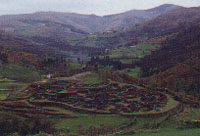Castros
15 Avientu, 2008 por Asturies.com




Los Castros are fortified Iron Age settlements. Although
we may intuit that their roots lie towards the end of the Bronze Age, there
is at present no archaeological evidence to support this, and the the oldest
examples date from the fifth century before Christ. Defensive considerations
condition their location, and they are always to be found in places difficult
to reach: upon capes or cliffy promontories along the coast, on mountains
or isolated inland elevations atop steep slopes or spurs commanding panoramic
views of the surrounding countryside. These natural defensive positions are
complimented by enormous earthworks centred around the most accessible parts
of the settlement: walls, ditches, parapets... the walls are generally of
rough masonry or rubblework on their outer face, filled up on the inside with
earth and stones, varying in width from two or three metres to six and a half
metres in the case of Campa Torres (Xixón). Points of access were usually
reinforced by double walls or more complex defenses such as turrets hard by
the entrance. In the case of the Castiellu de Podes (Gozón), for example,
access to the main space of the settlement is only possible by circurnambulating
an imposing central fortified turret.
Amongst these defenses the so-called murallas de módulos are especially worthy of attention, appearing in different Asturian fortified settlements: Castiellu de Moriyón (Villaviciosa), La Campa Torres (Xixón), Castielln de Vagii (Uviéu), Castro de San Chuis (Allande), etc. This technique consisted in the division of the wall into various independent sections with a rectangular base and rounded corners which were juxtaposed so that in the case of an attack the loss or destruction of one part would not affect the whole line of defence. The wall was usually the last line of defence, normally preceeded by more or less complex sysgtems of defensive ditches and counterditches, banks topped with wooden defences, etc. In some of the fortified settlements in the western part of Asturies (El picu da Mina and San Isidro) there are signs that stones were sunk into the ground for this purpose.
More recent archaeological excavations have revealed a more elementary type of dwellings which share the same groundplan and have walls made of interlaced poles plastered with clay and ponted with stones, fixed to a perimetric base of clay and stones. With thatched roofing atop upright supports, constructions of this type have been located at: Camoca and Moriyón (Villaviciosa), La Campa Torres (Xixón), Castiellu de Llagú (Uviéu) and Castiellu San Martin (Sotu'l Barcu). This type of dwelling is the most characteristic of Celtic Iron Age habitats in the Atlantic area, being widely documented in Ireland and in the culture of the hill-forts of the British Isles.
Amongst these defenses the so-called murallas de módulos are especially worthy of attention, appearing in different Asturian fortified settlements: Castiellu de Moriyón (Villaviciosa), La Campa Torres (Xixón), Castielln de Vagii (Uviéu), Castro de San Chuis (Allande), etc. This technique consisted in the division of the wall into various independent sections with a rectangular base and rounded corners which were juxtaposed so that in the case of an attack the loss or destruction of one part would not affect the whole line of defence. The wall was usually the last line of defence, normally preceeded by more or less complex sysgtems of defensive ditches and counterditches, banks topped with wooden defences, etc. In some of the fortified settlements in the western part of Asturies (El picu da Mina and San Isidro) there are signs that stones were sunk into the ground for this purpose.
More recent archaeological excavations have revealed a more elementary type of dwellings which share the same groundplan and have walls made of interlaced poles plastered with clay and ponted with stones, fixed to a perimetric base of clay and stones. With thatched roofing atop upright supports, constructions of this type have been located at: Camoca and Moriyón (Villaviciosa), La Campa Torres (Xixón), Castiellu de Llagú (Uviéu) and Castiellu San Martin (Sotu'l Barcu). This type of dwelling is the most characteristic of Celtic Iron Age habitats in the Atlantic area, being widely documented in Ireland and in the culture of the hill-forts of the British Isles.









